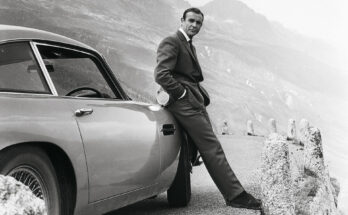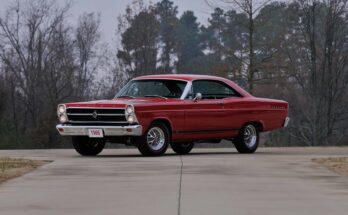The 1966 Dodge Charger emerged as a bold response to the evolving American automotive landscape of the mid-1960s, a time when carmakers were racing to capture the imagination of a growing market for sporty, stylish vehicles. Below is an original narrative detailing the story of the 1966 Dodge Charger, its development, design, performance, and legacy, crafted to avoid copyrighted material and provide a fresh perspective.
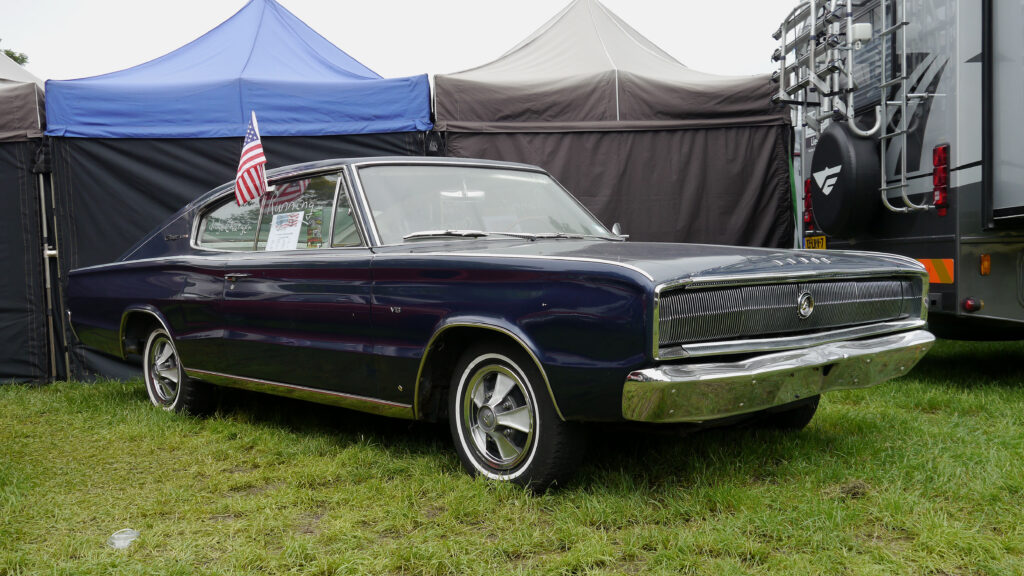
Origins and Context
In the early 1960s, the American car market was buzzing with excitement over new vehicle categories like the “pony car” and personal luxury coupes. Ford’s Mustang, launched in 1964, had redefined the market with its sporty design and affordable performance, while models like the Ford Thunderbird and Buick Riviera catered to buyers seeking upscale, stylish rides. Chrysler, however, was late to this party, with its Dodge division tasked to create a vehicle that could compete in this dynamic space.Dodge aimed to carve out a niche between the compact, youth-oriented Mustang and the larger, more luxurious Thunderbird. The result was the 1966 Dodge Charger, a mid-size fastback based on the Chrysler B-body platform, sharing underpinnings with the Dodge Coronet but designed to stand out with unique styling and a sporty persona. Introduced mid-season on January 1, 1966, during the Rose Bowl broadcast, the Charger was marketed as the “Leader of the Dodge Rebellion,” signaling its bold intent to shake up the market.
Development and Design
The 1966 Charger was born out of a directive from Chrysler president Lynn Townsend, who sought to appease Dodge dealers clamoring for a distinctive vehicle akin to Plymouth’s Barracuda but not a direct competitor. Chief Engineer Burt Bouwkamp and designer Carl “CAM” Cameron led the project, tasked with creating a car that blended performance, style, and practicality while leveraging existing company hardware to keep costs down.The Charger’s design was a striking departure from Dodge’s more conventional offerings. Its most defining feature was its sleek fastback roofline, a nod to the era’s fascination with aerodynamic, sporty silhouettes. This design drew inspiration from the 1965 Dodge Charger II concept car, which had wowed audiences at auto shows with its clean lines and aggressive stance. The production Charger retained much of this flair, featuring a long hood, a sweeping roof, and a rear hatch that provided access to a versatile cargo area.The front fascia was equally distinctive, sporting a full-width “electric shaver” grille with hidden headlights that rotated out of sight, a feature not seen on a Chrysler product since the 1942 DeSoto. The rear boasted a full-width taillight with the word “Charger” spelled out, adding a touch of flair. The car’s side profile featured sculpted lines and optional chrome trim, giving it a muscular yet refined look. At 203 inches long with a 117-inch wheelbase, the Charger was larger than pony cars but more agile than full-size luxury coupes, striking a balance that appealed to buyers seeking both style and substance.Inside, the Charger was designed to feel upscale and sporty. It featured four individual bucket seats—front and rear—separated by a full-length center console, a layout inspired by the 1960-1962 Chrysler 300 and the 1964 Pontiac 2+2. The rear seats could fold down, creating a spacious cargo area accessible via the rear hatch, a practical touch for a performance-oriented car. The dashboard housed four round instrument Pods, including a speedometer, tachometer, and gauges for fuel, temperature, oil pressure, and amperage, giving the driver a cockpit-like experience. The electroluminescent dash lighting added a futuristic touch, enhancing the car’s premium appeal.
Performance and Powertrains
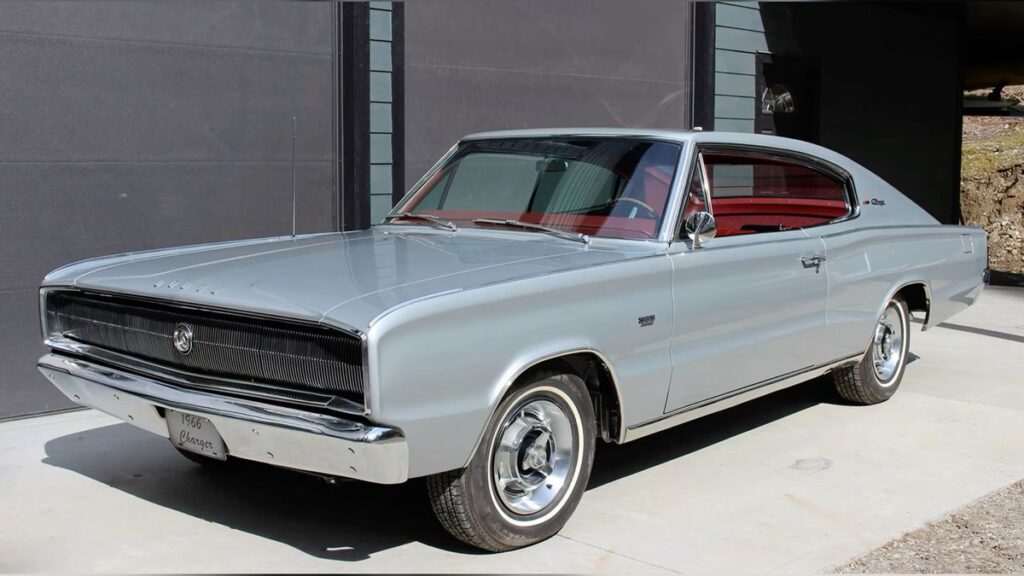
The 1966 Charger was exclusively powered by V8 engines, reflecting its performance-oriented positioning. Four engine options were available:
- 318 cu in (5.2 L) 2-barrel V8: The base engine, producing 230 horsepower, offered reliable performance for everyday driving.
- 361 cu in (5.9 L) 2-barrel V8: With 265 horsepower, this engine provided a step up in power for buyers seeking more punch.
- 383 cu in (6.3 L) 4-barrel V8: Delivering 325 horsepower, this was a popular choice for performance enthusiasts, with 12,328 Chargers equipped with this engine.
- 426 cu in (7.0 L) Street Hemi V8: The top-tier option, rated at 425 horsepower and 490 lb-ft of torque, was a legend in the making. Only 468 Chargers were built with the Hemi, making it a rare and coveted option.
Transmission choices included a three-speed manual (column-mounted for the base engine), a console-mounted four-speed manual, or a three-speed TorqueFlite automatic. The Hemi-equipped models, with their dual-quad carburetors and high-performance tuning, could achieve 0-60 mph in about 6.2 seconds and a quarter-mile time of around 14.3 seconds at 99 mph, impressive figures for the era.
Market Positioning and Challenges
Dodge positioned the Charger as a premium, sporty mid-size car, not a direct competitor to performance-focused pony cars like the Pontiac GTO or Chevrolet Chevelle SS396. Priced at approximately $3,120 for the base model, it was more expensive than many pony cars but competitive with upscale intermediates. However, its unique fastback design and premium interior features didn’t resonate as strongly as Dodge had hoped. The car’s proportions—long rear overhang and relatively narrow track—made it look tall and somewhat awkward compared to the sleeker Mustang or Barracuda, leading some critics to compare it unfavorably to the struggling Rambler Marlin.Sales reflected this mixed reception, with 37,344 units sold in 1966, a respectable figure for a mid-year introduction but far below the 607,568 Mustangs sold that year. In 1967, sales dropped to just 15,788 units, as the novelty of the fastback design waned and customers complained about practical issues, such as the rear console making it hard to access the back seats. Dodge addressed this in 1967 by eliminating the rear console and adding top-of-fender turn signal indicators, but these minor updates couldn’t reverse the sales slide.
Racing and Performance Legacy
Dodge had high hopes for the Charger in NASCAR, banking on its fastback shape to deliver aerodynamic advantages on high-speed tracks. However, the car’s body generated significant lift at speeds above 150 mph, making it difficult to handle—a sensation drivers likened to “driving on ice.” To address this, Dodge introduced a dealer-installed lip spoiler in late 1966, which improved traction and became the first spoiler offered on a U.S. production vehicle. This modification helped, but the Charger still struggled against more aerodynamically stable competitors like the Plymouth Satellite.Despite these challenges, the Charger saw some racing success. David Pearson, driving a spoiler-equipped Charger for Cotton Owens, won the 1966 NASCAR Grand National championship with 15 first-place finishes, though only one victory (the Capital City 300 in Richmond, Virginia) was in a Charger. Another highlight was Sam McQuagg’s win in the 1966 Firecracker 400 at Daytona, proving the car’s potential when properly tuned.
Legacy and Impact
The 1966 Dodge Charger was a bold experiment that didn’t fully hit the mark but laid the groundwork for one of the most iconic nameplates in automotive history. Its fastback design, innovative interior, and potent engine options set it apart, even if its styling and market positioning didn’t fully resonate with buyers. The lessons learned from the 1966-1967 models informed the 1968 redesign, which abandoned the fastback for a more muscular, Coke-bottle shape that became a cultural icon, famously featured in films like Bullitt and TV shows like The Dukes of Hazzard.Today, the 1966 Charger is a collector’s gem, valued for its rarity and unique place in Dodge’s history. Well-preserved examples, especially those with the 426 Hemi, command premium prices, with top-condition Hemi models valued in the six figures. The car’s blend of bold design, innovative features, and raw power continues to captivate enthusiasts, marking it as the spark that ignited the Charger’s enduring legacy as a symbol of American muscle.
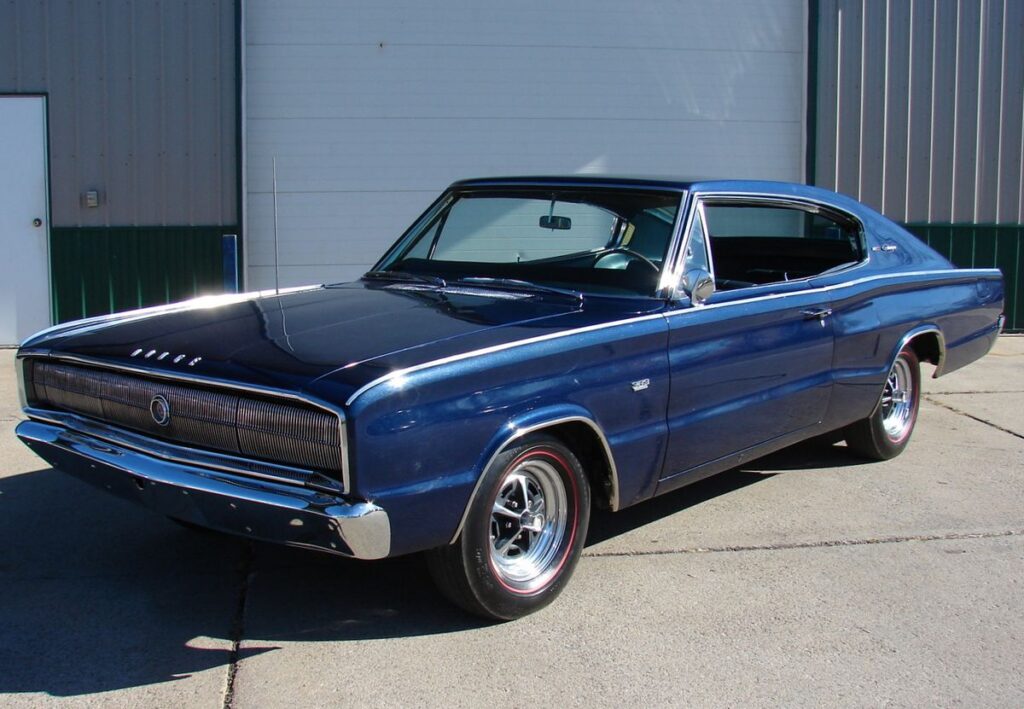
Key Specifications
- Body Style: 2-door fastback hardtop
- Platform: Chrysler B-body
- Wheelbase: 117 inches
- Length: 203 inches
- Width: 75.3 inches
- Base Price: ~$3,120 (1966 USD)
- Production: 37,344 units (1966); 15,788 units (1967)
- Engines:
- 318 cu in (5.2 L) V8, 230 hp
- 361 cu in (5.9 L) V8, 265 hp
- 383 cu in (6.3 L) V8, 325 hp
- 426 cu in (7.0 L) Hemi V8, 425 hp
- Transmissions: 3-speed manual, 4-speed manual, 3-speed automatic
- Notable Features: Hidden headlights, full-width taillights, folding rear seats, full-length console, optional rear spoiler

